IOT: OPPORTUNITIES AND USE CASES IN PEST CONTROL
- Pest Control
- Verfasst von Daniel Schröer
- 5 min. Lesezeit
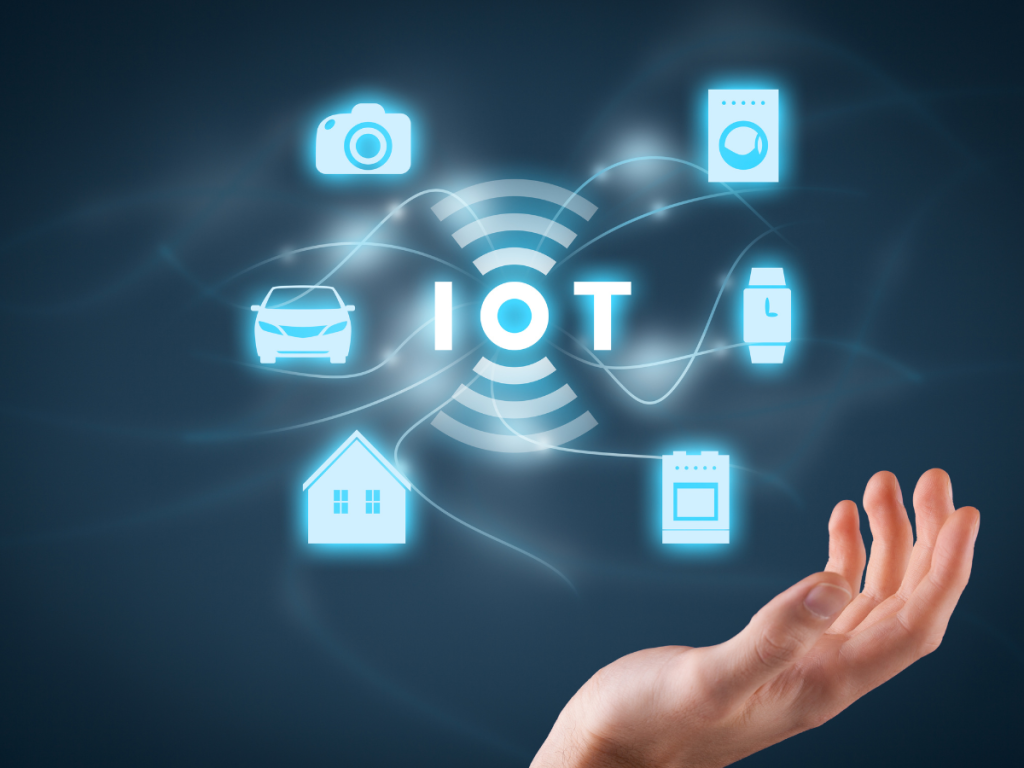
IOT DEFINITION - WHAT IS THE INTERNET OF THINGS?
The Internet of Things – also known as the Internet of Things – describes a network of physical objects that are equipped with technology such as sensors, SIM cards and software and can thus communicate with other objects. The Internet is often misleadingly not used at all. Instead of using WLAN, communication in industry in particular often takes place via network protocols that were developed specifically for the IoT.
One particularly well-known IoT example is smart home systems such as networked thermostats, blinds and furnaces that can be controlled via app while on the move. Simple “things” (Things) thus become objects that can collect, share and receive data.
This leads to…
more efficiency (e.g. in heating)
greater comfort (e.g. when parking)
and better safety (e.g. when driving).
It is not only private users who benefit from these IoT advantages. Exciting use cases of networked machines and products are also emerging in industry.
THIS IS WHY IOT IS CURRENTLY GAINING IN IMPORTANCE
According to data from the Hamburg-based market research company IoT Analytics, more than 12 billion IoT devices will exist worldwide in 2021, 165% more than in 2016. Over the next four years, IoT Analytics projects a compound annual growth rate of a full 22%.
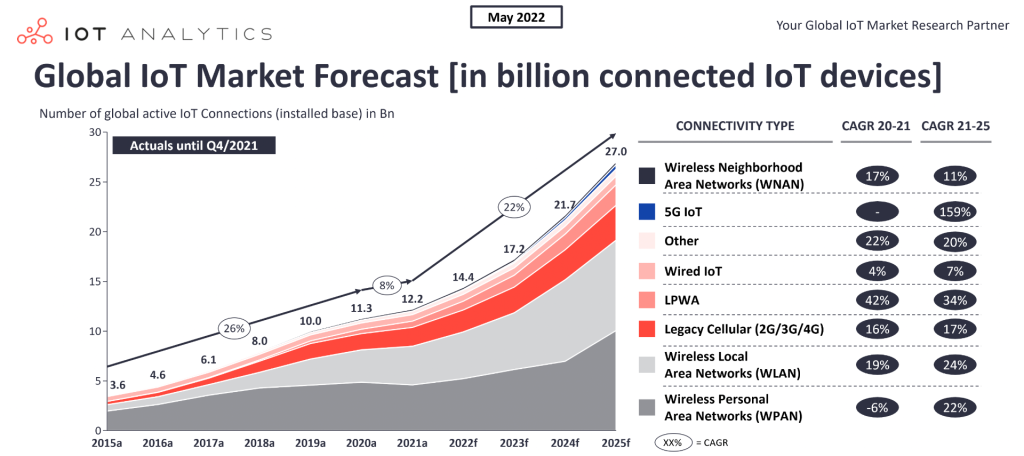
Source: IoT Analytics, March 2022
But what is leading to this rapid increase in IoT devices in use? According to Oracle , advances in several technologies are fueling the IoT boom:
Low-cost, energy-efficient sensor technology
Network protocols for efficient data transmission
Increasing availability of scalable cloud platforms
In addition, the following technologies complement the potential of IoT solutions:
4. advances in Machine Learning (ML) and Big Data.
5. enhanced natural language processing (NLP)
In short, the Internet of Things will become more viable as the technologies used evolve – that is, become more powerful and, at the same time, more cost-effective. Then the networking of more and more new devices will be worthwhile and more use cases will arise, both for private users and for companies.
IOT APPLICATIONS FOR BUSINESS
While private applications are usually simply about being able to control objects remotely, IoT applications in industry have a slightly different focus: IoT devices collect data about their environment via sensors. And it is precisely this data that companies can evaluate.
Here, by the way, the transition between the IoT and artificial intelligence (AI) is fluid. This is because the collected data is usually interpreted by (self-learning) algorithms and thus provides usable information for the company.
Typical enterprise IoT examples:
1. IoT devices for remote monitoring: IoT gives devices eyes and ears, so to speak. This means that equipment can keep an eye on whether everything is going according to plan at a production facility or wind farm. For example, sensors can measure the temperature of components and alert a service representative when abnormal values are detected. Or they detect built in beating traps when a rat was caught – more on that later.
2. predictive maintenance through IoT: predictive maintenance enables companies to plan the maintenance or repair of machine parts at an early stage. For this, remote monitoring data is interpreted by AI. For example, wear and tear on machine parts can be detected when it is just beginning to show.
3. optimized production and storage thanks to IoT: not only devices can be networked, but also products can be equipped with connecting components that enable data exchange between the product and its environment – for example along a production line or in a warehouse.
The Internet of Things thus brings companies a high degree of transparency and control. Through IoT systems, many manual tasks can be automated and further optimized thanks to the given process transparency. The bottom line is time and cost savings.
OUR IOT PLATFORM FOR PEST CONTROL
At Futura Germany, we started developing our IoT solution eMitter 17 years ago. Because there was a problem in professional pest control:
Strike traps must be checked daily for animal welfare reasons. This is an enormous expense for large farms, which is why poison baits were used far too often instead of environmentally and animal friendly traps. However, these are not only highly questionable, their use has also been severely restricted by law in recent years. For permanent baiting – apart from very special exceptions – poison baits have not been allowed for a long time.
IoT technologies are predestined for remote monitoring of beat traps. They can be easily equipped with sensors, a SIM card and, if necessary, a small camera. Networked strike traps like our eMitter traps automatically send a signal to a central server when they snap shut, which in turn sends push messages via email or app to a responsible person in the company or a pest controller.
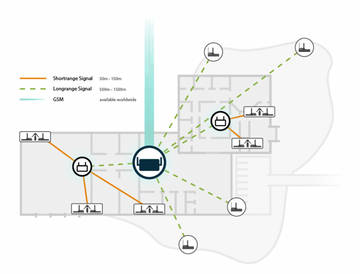
If cameras are installed in the trap, they can take a photo of the captured pest and send it directly with the trap. In our latest beat traps, the camera independently detects when a pest has entered the trap thanks to artificial intelligence and thus triggers the signal. This prevents false alarms – for example, if the trap was triggered because someone stepped on it.
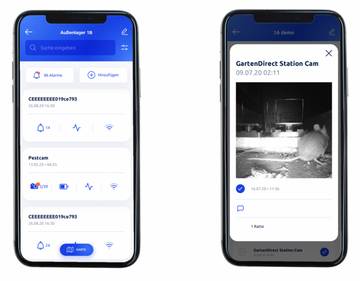
Insect traps can also be monitored according to this principle. A camera detects when and how many pests (e.g. cockroaches or moths) were caught and forwards the data accordingly.
And it gets even more practical: all the data that IoT devices collect on pests is automatically stored in a platform. This reveals trends, pest controllers can take countermeasures more quickly and monitor them for success. In addition, for an external audit (e.g. IFS Food or AIB), companies can show with just a few clicks how the infestation situation in the company is shaping up and has developed over time – an important criterion for successful audits.
Overall, a pest infestation with the Internet of Things can be detected much earlier and remediated more cost-effectively:
OUR IOT PLATFORM FOR PEST CONTROL
As the technologies behind the Internet of Things get better and cheaper, new use cases continue to emerge – from healthcare to logistics to our niche: pest control.
IoT solutions increase efficiency and reduce costs in the corporate context. In pest control, IoT technology also allows for a more environmentally and animal friendly approach to rodents and insects. This is because networked beat traps and monitoring cameras make the use of poison baits superfluous.
